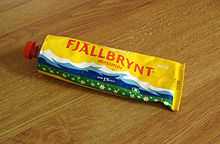Brunost
| Brunost | |
|---|---|
|
Brunost is usually sliced very thinly using a metal cheese slicer | |
| Type | Whey cheese |
| Main ingredients | Milk, cream, whey |
|
| |
Brunost, also called raudost [1] or mysost (Norwegian), or mesost (Swedish), meesjuusto (Finnish), mysuostur (Icelandic), myseost (Danish) or Braunkäse (German) is a caramelised brown Scandinavian whey cheese. The main Norwegian and the German names mean brown cheese, and the others mean simply whey cheese. Another variant, made using goat milk, is referred to and sold as geitost (Norwegian for "goat cheese") or sometimes elsewhere as gjetost /ˈjeɪtoʊst/). Geitost is made from a mixture of goat's and cow's milk, and ekte geitost (real geitost) is made with goat's milk only. It is produced and consumed primarily in Norway, and may be described as "quintessentially Norwegian". [2]
Production
Brunost is made by boiling a mixture of milk, cream, and whey carefully for several hours so that the water evaporates. The heat turns the milk sugar into caramel, which gives the cheese its characteristic brown colour and sweet taste.[3] It is ready for consumption as soon as it is packed in suitable sized blocks. A low-fat variant is made by increasing the proportion of whey to milk and cream.

If boiled for a shorter time, the soft, spreadable version called prim in Norwegian (or messmör in Swedish and mysingur in Icelandic), similar to dulce de leche, is produced. Prim had been made in Norway for a long time when Anne Haav (Anne Hov in some sources), a milk maid in Gudbrandsdalen, got the idea of putting cream into the cheese and invented the Fløtemysost. She found that the cheese was better and easier to cut by increasing the percentage of fat with the addition of cream. She received a good price for her new cheese, and this merchandise is said to have saved the Gudbrandsdalen financially in the 1880s. In 1933, when Anne Haav was 87 years old, she was awarded the King's Medal of Merit in silver.
Brunost is manufactured primarily in Norway, but also has traditionally been produced in Jämtland and Härjedalen in Sweden. The cheese is sold by specialty cheese shops and some larger supermarkets in North America and Europe. Today, several types of brunost are offered in most shops in Norway and Sweden.
TINE produces most of the brunost in Norway, and currently has 12 varieties to choose from. In Sweden, Fjällbrynt is the biggest producer and produces brunost called Fjällbrynt Mesost in the city of Östersund. In Iceland, Mjólkursamsalan produces brunost. Several local dairies in Norway produce their own versions.
Nutritional value
Brunost has traditionally been considered healthy because of its high content of iron, calcium and B vitamins, but one Norwegian nutritionist, Fedon Lindberg, says that because brunost contains large quantities of both fat and sugar it is nutritionally comparable to milk chocolate and that Norwegians should eat less of it.[4] A test by the newspaper Dagbladet also scored the cheese poorly in terms of nutrition.[5] Brunost does not contain significant amounts of iron today, due to the manufacturing methods used. The iron used to come from its being made in iron pots. Some types have added iron, but only those that state this clearly on the package.
Tunnel fire
In January 2013, the Bratli Tunnel at Tysfjord was damaged when a lorry load of caramelised brunost caught fire. The high concentration of fat and sugar in the cheese caused it to burn fiercely at sufficiently high temperatures that the fire was still burning five days later.[6][7]
References
- ↑ Lucy Gillmore, "Lucy Gillmore pushes past snow-laden trees ...", The Independent, 14 January 2001.
- ↑ http://www.theguardian.com/lifeandstyle/wordofmouth/2013/jan/24/brunost-norwegian-cheese-hot-topic
- ↑ Terri Dunbar-Curran, "Whey to go: Choose cheese", Cape Times, 26 April 2012.
- ↑ Ole Bjørner Loe Welde and Ulf André Andersen, "Advarer mot brunost", Dagbladet, 15 August 2003 (Norwegian)
- ↑ Gunn Helene Arsky, "Sunne og usunne brunoster: Vi har testet 18 brunoster - det ernæringsmessige spriket er stort", Dagbladet, 4 March 2011 (Norwegian)
- ↑ "Norway goat cheese fire closes tunnel", BBC News Europe, 22 January 2013.
- ↑ Korva Coleman, "Burning Cheese Closes Norwegian Road For Days", The Two-Way, NPR, 23 January 2013.
Further reading
- Arne Espelund. Brunosten, historien til et godt næringsemne gjennom 300 år. Trondheim: Arketype forlag, 1998. ISBN 82-992430-2-5 (Norwegian)
External links
- Preben S. Ottesen, "Brunost", Store norske leksikon (Norwegian)
| ||||||
